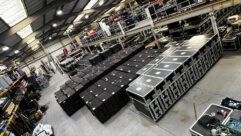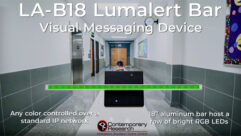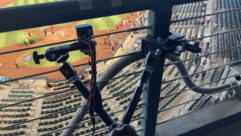
AV Lockdown
As growing sales in the commercial and consumer market can attest, AV gear is fast becoming a ?must-have? for many end-users. For some, that means sawing through cables, picking locks, dodging security cameras, or just yanking things off of a wall. Theft of AV gear ? and the related damage, user inconvenience, and rising costs of preventing it ? is a problem that is increasing.
As growing sales in the commercial and consumer market can attest, AV gear is fast becoming a “must-have” for many end-users. For some, that means sawing through cables, picking locks, dodging security cameras, or just yanking things off of a wall. Theft of AV gear — and the related damage, user inconvenience, and rising costs of preventing it — is a problem that is increasing.
Multiple theft-deterring methods were combined in this installation at the University of California at San Diego.
As more projectors, displays, cameras, audio gear, and computers fill public and private spaces, thieves may be taking note. Considered easy targets in many venues, the gear can be enticing to those who spot a chance to make off with snazzy technology they can turn for a quick buck or keep for personal use.
The growth of digital signage, more collaborative technology in education, and the use of displays and audio gear in venues such as museums, dining and drinking establishments, casinos, and houses of worship, means more AV gear in plainer sight than ever. Making AV equipment more impervious to theft is well within the reach of integrators and their customers, and increasingly in demand. It comes down to deciding which remedy or combination of remedies are best, given the vulnerability level and what’s appropriate and affordable for the particular environment. They fall into a few classes, spanning different types of AV assets. Here’s an overview of ways to keep AV technology where it belongs.
Physical Barriers
Cages, enclosures, high-strength cables and bolts, complex locks, security screws, and covers and placements that complicate access are a relatively low-tech way of protecting assets. Anything that can secure an asset to a wall, ceiling, or other mounting or connection surface reduces the chance of theft.
“The best approach is to be a pain in the butt for thieves,” says Ed Gallin, owner of KSL Security & Printer Services, a Waltham, Mass.–based company that markets physical security products for computers and AV products. “One of the keys to stopping thieves is making it tougher for them to make off with something. Usually, they just want to grab it and go.”
The roster of products that make it more difficult to do just that is growing. Custom-designed devices that enable fixed assets like projectors, displays, and loudspeakers to be locked into place are increasingly available. In addition, some AV gear comes with integrated physical security features.
Mounts for projectors, probably the most stolen AV device, increasingly are paired with security features. Some mount manufacturers offer different levels and types of locks and fastening devices. From locking levers to keyed lock boxes to cages that fully enclose the unit, the mounts — some of which incorporate all of these barriers — are designed to thwart all but the most skilled or persistent thieves. Still other mount packages can be enhanced with security cables, which are sold separately.
For display device security, integrators and end-users are looking to new types of enclosures. Designed as a housing, enclosures securely attached to a mounting surface and increasingly feature key locks on hinged covers that must be opened to access the device.
QSC’s IntelliDock feature makes the loudspeaker both easier to install and less prone to theft.
Although they’re less sought after, loudspeakers are increasingly being locked down as well. QSC Audio Products in Costa Mesa, Calif., touts its IntelliDock intelligent mounting system’s security features. Available in some of its products, the system combines all the components needed to mount, wire, and position the speaker into a single housing separate from the enclosure, making the enclosure’s removal difficult.
When properly designed and affixed, physical deterrents can be near foolproof, but they’re not without drawbacks. Many types of standard cables sold by AV device makers can be easily cut with the right tools. Heavier duty aircraft-style cables that require a bolt cutter to sever them are usually a more solid choice, notes Gallin. Security screws that hold mounts and devices in place — usually types that can’t be removed with standard wrenches or screwdrivers or difficult and time-consuming because of their design to remove —are unlikely to deter serious thieves with a well-stocked toolbox, but they can frustrate many.
Aside from their functionality, physical barriers have their pros and cons. Often clearly evident, they can make thieves think twice about even making an attempt. At the same time, some types (such as cages) may send the wrong message. For example, on a college campus, a “locked-down” look may draw more attention to the projector.
Alarms
Arming AV gear with devices that detect tampering and trigger alarms is another method of foiling thieves. However, unless they’re thoughtfully selected and installed, these devices can make a headache of routine maintenance or allow thieves to get just far enough in their attempts to cause product damage.
Ernie Bailey, director of AV services for the University of Arkansas Medical Sciences in Little Rock, Ark., employs the Sonic Shock alarm marketed by Secure-It in East Longmeadow, Mass. Designed to be fused with a “super” glue to a baseplate on a device, the alarm’s siren, which sounds for more than two hours, is triggered by severing an electronically monitored tether.
“We had this product on order when several of our classroom projectors were stolen,” says Bailey. “We’re now using this product to secure many pieces of AV equipment, even if it comes with traditional security cables. One advantage of the product is that it carries a warning sticker not to unplug or cut the tether or an alarm will sound.”
Other types of alarms that trigger when a product is tampered with can be linked to venue security systems.
A sonic alarm is fused to the product’s housing, making it difficult to remove without damage. Even if it is removed, a painfully loud alarm should deter theft.
“Tamper sensors that connect to a central alarm [such as magnetic latches that, if moved, trip a switch that activates an alarm] are used, but one drawback is they might not trigger until a device has been completely removed,” says Malcom Montgomery, former technology manager for the University of Cincinnati, who now serves as president of EduTech Consulting Services in Cincinnati. “The best types are systems that are tripped before the unit can be removed and those that require something time-consuming to do.”
An ideal solution, he says, are alarm systems that employ stick-on security tabs that can be affixed over critical screws or other types of fasteners that must be accessed to remove a device. One he recommends is a product called the PC Tab. Marketed by Computer Security Products, based Nashua, N.H., the product embeds a membrane sensor into a security sticker that is affixed to an AV asset. If the sticker is peeled off, the sensor, which is linked via a cable to a central alarm system, will trigger an alert.
“If you put these types of stickers in the right location, they can work well,” he says. “But I’d make sure it’s connected to an audible alarm system so the thief is more likely to be scared off. In the education area, in particular, silent alarms can be trouble because they’re more likely to lead to potentially dangerous confrontations.”
Remote Monitoring
As more AV gear resides on networks and security cameras become more commonplace in venues of all sorts, there are growing opportunities to keep 24-7 tabs on who — and what — may be coming and going.
Nowadays, many IP-based control systems marketed by Crestron Electronics, AMX Corp., and others incorporate the capability of monitoring the status of projectors, displays, sound equipment, and other types of AV gear. In addition to ensuring proper performance and maintenance of the equipment, the systems also are constantly monitoring their presence. If the gear is disabled or removed, the systems can be configured to send alerts to remote system computers.
“More and more equipment now is networkable, residing on networks that have security features that send an e-mail to a network administrator if something is unplugged,” says Bailey. “We don’t have that kind of broad network capability now, but we’re developing it partly as another block in our overall security wall.”
The drawback of a network monitoring solution, of course, is that by the time an alert is sent and a response is mounted, the equipment may be long gone. But in venues that are closely monitored — and in which a rapid response can be made — a theft could be disrupted. As a preventive tool, monitoring has obvious drawbacks; the average thief is probably not aware of the capability. Surveillance cameras, however, do offer more of that preventive capability, as well as the ability to catch a thief in the act or after the fact. But without round-the-clock monitoring and the ability to train cameras in just the right areas, they may be marginal in their ability to deter or prevent AV device theft.
Dan Oliver, AV specialist with the National Museum of the U.S. Air Force in Dayton, Ohio, says he relies heavily on a network of security cameras to monitor AV equipment in the facility. Though he’s had little, if any, thefts occur, he’s confident the facility’s extensive CCTV system and associated cameras provide an adequate deterrent and method of foiling theft.
“There’s a single point of entry and exit from the museum that’s closely monitored, so the chances of anything slipping out are slim,” he says.
Reduce the Attraction
Thieves usually steal AV gear for two reasons: money, or enjoyment. Rare is the malicious thief. Making equipment hard or impossible to use, branding it the property of the owner, or simply making it unattractive are some methods that might make thieves think twice. For example, some digital gear, such as projectors and displays, can be programmed to require user access codes or to display a “property of” message on startup. That can help in recovery of stolen gear and identification of culprits, but it’s not necessarily an effective deterrent.
The Protector from Sahara Presentation Systems works like a car stereo with a removable faceplate. Once installed, the panel is removed and taken out of the classroom where the projector is located. Each projector has a unique serial coded panel, and it recognizes only that panel. Replace it with an unauthorized panel, and the projector will not work.
“That’s more of a recovery tool,” Montgomery says. “If you have some sort of ID feature like that, it’ll make the gear harder to sell. If it turns up back with the vendor that sold it for service, that theft might have a better chance of being flagged.”
Concealing ownership information in a part of a piece of gear that only would be accessed by a dealer is another way of possibly recovering stolen gear, he says. Physical forms of identification or “defacing” of sorts can also be effective.
“Another good tool is a branding iron that allows the name of the owner to be put on a plate that’s soldered on to the unit,” he says. “They’re impossible to remove, affect the resale value, and can deter if it’s clearly visible. It’s much more permanent than putting a sticker with the owner’s name on the gear.”
Another trick, he says, is “uglification.” Spray painting part of an item fluorescent orange, for instance, or branding the product in some visible way is a method of making it unattractive for use or resale. That fix, however, has serious drawbacks from an aesthetics standpoint.
A problem that’s more acute for some end-users, such as those in the education market where open and frequently unmonitored classrooms can be an invitation to thieves, theft is a growing concern as products of all types become more ubiquitous. And while AV equipment theft probably hasn’t reached epidemic proportions, more end-users, product manufacturers, and systems integrators are recognizing the vulnerability of products and implementing fixes of various combinations to thwart thieves.
As Montgomery notes, “the philosophy of security, generally, is the more you do, the luckier you get.”
Tom Zind is a freelance writer based in Lee’s Summit, Mo. He can be reached at [email protected].










